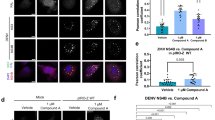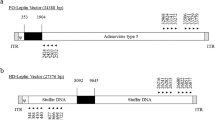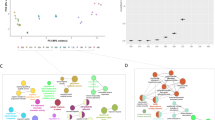Abstract
High transgene stabilities of 1 year and more have been reported in immunodeficient hosts after adenovirus-mediated gene transfer. Transgene persistence of this duration could be due to inherently high stability of the episomal viral vector DNA. An alternative explanation would be limited ‘autoreplication’ of transgenic vector DNA, just sufficient to counteract slow but continuous degradation within the host cells. Autoreplication could occur in the absence of any production of infectious virus particles, based on residual activity of the adenoviral DNA replication system only. To test this hypothesis, a series of DNA metabolic labeling studies in non-permissive cells cultures transfected with different vectors was conducted. Due to extensive E1 region deletions none of the vectors was able to produce viral progeny in non-permissive cells. Vectors fell into two categories, however, with respect to their autoreplication potential. Neosynthesis of vector DNA in non-permissive vector-transfected cells was readily detectable in ‘type A’, but not in ‘type B’ vectors. In addition to their different transgene expression cassettes, vector DNA sequencing showed a less extensive E1 deletion in type A (nucleotides 453–3333 of wild-type virus) as compared to type B vectors (nucleotides 325–3523). Autoreplication was also associated with high transcriptional activity of several viral genes (E1B-14k, adenoviral DNA polymerase, single-strand DNA-binding protein, E4-25k), in contrast to type B vectors. In addition to these ‘wild-type’ transcripts, ‘irregular’ recombinant transcripts were detected in autoreplication vectors which contained the transgenic cDNA in conjunction with adenoviral vector sequences. Exogenous or cryptic promotors may (under certain conditions) enhance the transcriptional activity of a vector in such a way that autoreplication occurs. Conditions determining the level of transcriptional enhancement (extent of E1 deletion, type of promoter and transgene, etc) need to be further defined before rational design of adenovectors with high autoreplication capacity becomes possible. In summary, we have shown autoreplication to be a novel feature of certain E1-deleted adenovectors with likely relevance for their stability in vivo, but also with possibly adverse consequences for target cell function or vector immunogenicity. Full characterization of adenoviral vector systems should therefore include a description of their autoreplication capacity.
This is a preview of subscription content, access via your institution
Access options
Subscribe to this journal
Receive 6 print issues and online access
$259.00 per year
only $43.17 per issue
Buy this article
- Purchase on SpringerLink
- Instant access to full article PDF
Prices may be subject to local taxes which are calculated during checkout








Similar content being viewed by others
References
Byun J et al. Analysis of the relative level of gene expression from different retroviral vectors used for gene therapy Gene Therapy 1996 3: 780–788
Lynch C et al. Adeno-associated virus vectors for vascular gene delivery Circ Res 1997 80: 497–505
Rubenstein R et al. CFTR gene transduction in neonatal rabbits using an adeno-associated virus (AAV) vector Gene Therapy 1997 4: 384–392
Li Q et al. Assessment of recombinant adenoviral vectors for hepatic gene therapy Hum Gene Ther 1993 4: 403–409
Miller R, Curiel D . Towards the use of replicative adenoviral vectors for cancer gene therapy Gene Therapy 1996 3: 557–559
Sun T-Q, Livanos E, Vos J-M . Engineering a mini-herpesvirus as a general strategy to transduce up to 180 kb of functional self-replicating human mini-chromosomes Gene Therapy 1996 3: 1081–1088
Sun T-Q, Fenstermacher D, Vos J-M . Human artifical episomal chromosomes for cloning large DNA in human cells Nat Genet 1994 8: 33–41
Wohlgemuth J et al. Long-term gene expression from autonomously replicating vectors in mammalian cells Gene Therapy 1996 3: 503–512
Horwitz M . Adenoviridae and their replication In: Fields B et al (eds). Virology Raven Press, New York 1990 pp 1679–1721
Doerfler W, Böhm P . The molecular repertoire of adenoviruses In: Capron A et al (eds). Current Topics in Microbiology and Immunology Springer: Berlin, Heidelberg, New York 1995 p 880
Ilan Y et al. Insertion of the adenoviral E3 region into a recombinant viral vector prevents antiviral humoral and cellular immune responses and permits long-term gene expression Proc Natl Acad Sci USA 1997 94: 2587–2592
Kay M et al. Long-term hepatic adenovirus-mediated gene expression in mice following CTLA4Ig administration Nat Genet 1995 11: 191–197
Poller W et al. Stabilization of transgene expression by incorporation of E3 region genes into an adenoviral factor IX vector and by transient anti-CD4 treatment of the host Gene Therapy 1996 3: 521–530
Levine A . The adenovirus early proteins Curr Topics Microbiol Immunol 1984 110: 143–167
Michou A et al. Adenovirus-mediated gene transfer: influence of transgene, mouse strain and type of immune response on persistence of transgene expression Gene Therapy 1997 4: 473–482
Kaplan J et al. Humoral and cellular immune responses of nonhuman primates to long-term repeated lung exposure to Ad2/CFTR-2 Gene Therapy 1996 3: 117–127
Yang Y et al. Immune response to viral antigens versus transgene product in the elimination of recombinant adenovirus-infected hepatocytes in vivo Gene Therapy 1996 3: 137–144
Yang Y, Wilson J . Clearance of adenovirus-infected hepatocytes by MHC class I-restricted CD4+ CTLs in vivo J Immunol 1995 155: 2564–2570
Yang Y, Trinchieri G, Wilson J . Recombinant IL-12 prevents formation of blocking IgA antibodies to recombinant adenovirus and allows repeated gene therapy to mouse lung Nature Med 1995 1: 890–893
Schowalter D et al. Heterologous expression of adenovirus E3-gp19k in an E1a-deleted adenovirus vector inhibits MHC I expression in vitro, but does not prolong transgene expression in vivo Gene Therapy 1997 4: 351–360
Yang Y et al. Inactivation of E2a in recombinant adenoviruses improves the prospect for gene therapy of cystic fibrosis Nat Genet 1994 7: 362–369
Fang B et al. Lack of persistence of E1− recombinant adenoviral vectors containing a temperature-sensitive E2A mutation in immunocompetent mice and hemophilia B dogs Gene Therapy 1996 3: 217–222
Lieber A, He C-Y, Kirilova I, Kay M . Recombinant adenoviruses with large deletions generated by Cre-mediated excision exhibit different biological properties compared with first-generation vectors in vitro and in vivo J Virol 1996 70: 8944–8960
Mitani K, Granam F, Caskey C, Kochanek S . Rescue, propagation, and partial purification of a helper virus-dependent adenovirus vector Proc Natl Acad Sci USA 1995 92: 3854–3858
Gorziglia M et al. Elimination of both E1 and E2a from adenovirus vectors further improves prospects for in vivo human gene therapy J Virol 1996 70: 4173–4180
Nelson J, Kay M . Persistence of recombinant adenovirus in vivo is not dependent on vector DNA replication J Virol 1997 71: 8902–8907
Yang Y et al. Cellular immunity to viral antigens limits E1-deleted adenoviruses for gene therapy Proc Natl Acad Sci USA 1994 91: 4407–4411
Yang Y, Hildegund C, Wilson J . MHC class I-restricted cytotoxic T lymphocytes to viral antigens destroy hepatocytes in mice infected with E1-deleted recombinant adenoviruses Immunity 1994 1: 433–442
Heise C et al. ONYX-015, an E1B gene attenuated adenovirus, causes tumor-specific cytolysis and antitumoral efficacy that can be augmented by standard chemotherapeutic agents Nature Med 1997 3: 639–645
Garver R et al. Adenovirus replication in non-small cell lung cancer Am J Resp Crit Care Med 1998 157 (Suppl.): A479
Clesham G et al. High adenoviral loads stimulate NF-dependent gene expression in human vascular smooth muscle cells Gene Therapy 1998 5: 174–180
Thimmappaya B, Weinberger C, Schneider R, Shenk T . Adenovirus VAI RNA is required for efficient translation of viral mRNAs at late times after infection Cell 1982 31: 543–551
Gambaryan S et al. cAMP-stimulated renin release from rat isolated perfused kidney, microdissected glomeruii, and isolated juxtaglomerular cells is inhibited by endogenous or overexpressed cGMP-dependent protein kinases Proc Nat Acad Sci USA 1998 95: 9003–9008
Vaandrager A et al. cGMP stimulation of CFTR Cl− channels co-expressed with cGMP-dependent protein kinase type II, but not type Iβ J Biol Chem 1997 272: 4195–4200
Poller W et al. Modulation of vascular cell proliferation by transfer of the genes encoding nitric oxide synthase III, cGMP-dependent protein kinases cGKIβ and cGKII, and preproendothelin-1 Circulation 1997 96 (Suppl.): 484
Poller W et al. Molecular characterization of the defective a1-antitrypsin alleles PI Mwürzburg (Pro369Ser), Mheerlen (Pro369Leu), and Q0lisbon (Thr68lle) Eur J Hum Genet (in press)
Watzka M et al. An optimized protocol for mRNA quantification using nested competitive RT-PCR Biochem Biophys Res Commun 1997 231: 813–817
Ho S et al. Site-directed mutagenesis by overlap extension using the polymerase chain reaction Gene 1989 77: 51–59
Acknowledgements
This work was supported by the Deutsche Forschungsgemeinschaft through a Heisenberg fellowship to WP (378/2–1 and 378/2–2), and by the Cardiovascular Research Center at the University Hospital Benjamin Franklin, Freie Universität Berlin. The project was also supported by a grant from Centeon Pharmaceutical Company.
Author information
Authors and Affiliations
Rights and permissions
About this article
Cite this article
Marienfeld, U., Haack, A., Thalheimer, P. et al. ‘Autoreplication’ of the vector genome in recombinant adenoviral vectors with different E1 region deletions and transgenes. Gene Ther 6, 1101–1113 (1999). https://doi.org/10.1038/sj.gt.3300928
Received:
Accepted:
Published:
Issue date:
DOI: https://doi.org/10.1038/sj.gt.3300928
Keywords
This article is cited by
-
Extended Transgene Expression From a Nonintegrating Adenoviral Vector Containing Retroviral Elements
Molecular Therapy (2008)
-
Coxsackievirus B3 and adenovirus infections of cardiac cells are efficiently inhibited by vector-mediated RNA interference targeting their common receptor
Gene Therapy (2007)
-
Highly efficient and specific modulation of cardiac calcium homeostasis by adenovector-derived short hairpin RNA targeting phospholamban
Gene Therapy (2007)
-
Tamoxifen-regulated adenoviral E1A chimeras for the control of tumor selective oncolytic adenovirus replication in vitro and in vivo
Gene Therapy (2006)
-
An improved Tet-On regulatable FasL-adenovirus vector system for lung cancer therapy
Journal of Molecular Medicine (2006)



